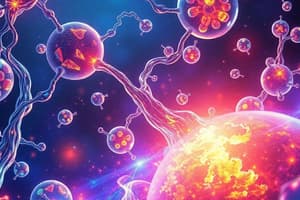Podcast
Questions and Answers
Which statement is the most accurate description of the role of a catalyst in a chemical reaction?
Which statement is the most accurate description of the role of a catalyst in a chemical reaction?
- It provides an alternative pathway with lower activation energy. (correct)
- It alters the equilibrium of a reversible reaction.
- It is used up at the end of the reaction.
- It increases the number of products formed in a reaction.
In a neutralization reaction between hydrochloric acid and sodium hydroxide, what are the products formed?
In a neutralization reaction between hydrochloric acid and sodium hydroxide, what are the products formed?
- Sodium chloride and water. (correct)
- Sodium hydroxide solution and hydrogen ions.
- Chlorine gas and sodium oxide.
- Hydrogen gas and a sodium chloride solution.
How many molecules are present in a 2-mole sample of hydrogen gas (H2)?
How many molecules are present in a 2-mole sample of hydrogen gas (H2)?
- 2.408 x 10^24 molecules
- 3.01 x 10^23 molecules
- 1.204 x 10^24 molecules (correct)
- 6.02 x 10^23 molecules
Which of the following best describes an exothermic chemical reaction?
Which of the following best describes an exothermic chemical reaction?
Which of the following best describes a displacement reaction?
Which of the following best describes a displacement reaction?
Flashcards
Catalyst
Catalyst
A substance that increases the rate of a reaction without being changed.
Exothermic Reaction
Exothermic Reaction
A reaction that releases heat, resulting in a negative ΔH.
pH
pH
A scale from 0 to 14 indicating acidity or alkalinity of a solution.
Neutralization
Neutralization
Signup and view all the flashcards
Mole
Mole
Signup and view all the flashcards
Study Notes
Chemical Reactions
- Catalyst: A substance that speeds up a reaction without being chemically changed. It lowers the activation energy.
- Enzyme: A biological catalyst, an example is Amylase.
- Relative Formula Mass: The sum of the atomic masses of all elements in a compound, expressed in grams.
- Mole: One mole of any substance contains the same number of molecules/atoms as 12 grams of carbon-12 (Avogadro's constant, 6.02 x 1023).
- Exothermic Reaction: A reaction that releases heat (ΔH is negative).
- Endothermic Reaction: A reaction that absorbs heat (ΔH is positive).
- pH: A scale (0-14) that indicates whether a solution is acidic, neutral, or alkaline.
- Base: A substance with a pH higher than 7. Bases react with acids to form salts and water. Examples include metal hydroxides, oxides, and carbonates.
- Acid: A substance with a pH less than 7. Acids react with bases to form salts and water. Acidity is caused by a high concentration of hydrogen ions.
- Alkali: A soluble base (a base that dissolves in water). Alkalis have a pH greater than 7 and react with acids to form salts and water. They have a high concentration of hydroxyl ions (OH-).
- Neutralization: A reaction where an acid and a base react to form a salt and water. H+ + OH- → H2O
- Combustion: A reaction where a substance burns in oxygen, forming an oxide and releasing energy.
- Displacement: A reaction where a more reactive element takes the place of a less reactive element in a compound.
Studying That Suits You
Use AI to generate personalized quizzes and flashcards to suit your learning preferences.




